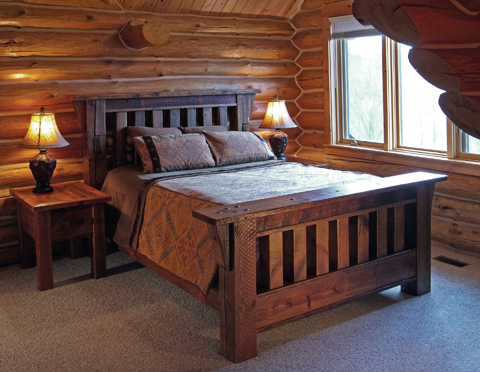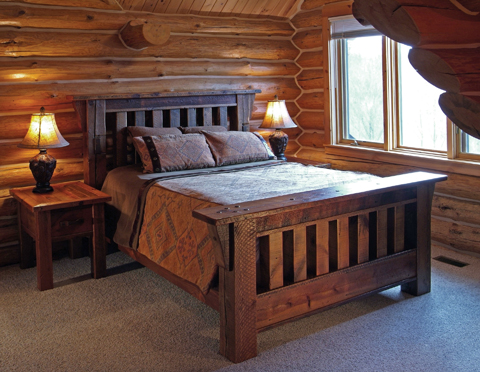Once you have finalized the plans for your new log home, it’s time to start thinking about how you are going to furnish and decorate it. If you did a lot of research and put a lot of effort into making sure your new home is environmentally healthy and safe, you’ll need to do the same for the furniture for your beautiful home.
One of the first things to consider is whether you can reuse any of the furniture from your current home. Can a sofa or chair be reupholstered or refinished? Can a table be refinished or painted? Can curtains or other window treatments be cleaned and altered for your new home? Can any of the furniture or other items be repurposed and used? Items that cannot be reused can be given to family members, donated to charity, or sold through consignment, yard sale, eBay, Freecycle, or Craigslist. The only place you don’t want to send your old furniture is to the landfill, where it may contaminate the soil.
Antiques are a good choice for your log home. They have been around for a long time and have acquired a lovely patina. If they have been in your family for generations they have sentimental as well as monetary value. Buying antiques especially for your new home gives them a longer lifespan and they can be passed down to your children and grandchildren. They are a smart financial investment and an eco-friendly addition to your home. Vintage furniture may not be as strong an investment, but it can add character and personality to your home. If you purchase the vintage items near your log home they’ll provide a sense of the area’s history.
You know that new car smell that brings a smile to your face? That’s a result of offgassing. Synthetic materials or those treated or constructed with synthetic substances offgas toxic chemicals. Volatile organic compounds (VOCs) are the most common form of offgassing; they have been known to cause birth defects, endocrine disruption, and cancer. Furniture is particularly known for offgassing formaldehyde. Also beware of fire retardants and stain repellants. Brominated flame retardants (PBDEs) may cause brain disorders and birth defects; they have been banned in Europe but are still used extensively in the rest of the world. Stain repellants extend the life of fabric, which is green, but they also offgas VOCs for months. Safe and eco-friendly alternatives are available.

FABRICS
When you hear the words “cotton,” “linen,” or “wool,” your first thought is that they are green because they are natural fibers. When going green, however, you have to consider many other factors that go into producing a fabric. The first thing you need to know is where the fibers that make up the fabric are from and how they are processed. Are they from a renewable resource? Does growing the crops require pesticides and chemicals, and do those chemicals seep into the ground and nearby waterways? Are the fabrics produced under fair trade practices? (Fair trade promotes sustainability in developing countries.) Does the company treat employees well and provide them with fair wages and healthy working conditions? Is the fabric manufactured using toxic chemicals or protected with toxic stain repellents or fire retardants? At the end of its life, can the fabric be recycled or is it biodegradable? All of these factors affect the environment.
Cotton. After China, the United States is the second largest producer of cotton in the world. It generates more revenue than any other crop. It is easy to process into fabrics of various types and its by-products include the cottonseed oil used in salad dressings and snack foods. Cotton plants are susceptible to insect infestation and disease, so chemicals are used in growing it. About 25 percent of all chemical pesticides used on American crops are applied to cotton. Those pesticides remain in the soil long after the crop has been abandoned, seeping into groundwater and poisoning wildlife. Organic cotton is grown without pesticides or other chemicals. Instead, farmers use biological methods to get rid of pests and adjust planting patterns to reduce the need for fungicides.
Linen. Linen yarn is spun from the fibers located just behind the bark on the stem of a flax plant. To get the fibers from the plant, the woody stem and inner pith (pectin) that holds the fibers in a clump have to be rotted away in a process called retting. Retting creates butyric acid, methane, and hydrogen sulfide, which pollute the environment. If the water used in the retting process isn’t treated before it is disposed of, it will pollute the waterways. Organic flax is weeded manually and crops are rotated to lessen the need for chemicals. The flax is artificially retted so there are no toxins in the wastewater. Most linen is imported into the United States from countries where labor is inexpensive and plentiful; the harvesting of flax is a labor-intensive process.
Bamboo. We’re starting to see a lot more bamboo fabrics in the United States—in sheets, towels, curtains, and upholstery fabrics. Bamboo is naturally antibacterial, sustainable, renewable, grows quickly, and requires no pesticides. Growing it actually benefits the environment: it absorbs four times the carbon dioxide as trees, and releases 35 percent more oxygen.
Hemp. Hemp is a variety of the plant species Cannabis satvia L. The primary fibers are used for textiles, cordage, and fine paper products; the core fiber can be used as mulch or animal bedding and in building materials. Once the crop is cut, the stalks are allowed to rett in the field for four to six weeks—depending on the weather—to loosen the fibers. While the stalks lay in the field, most of the nutrients extracted by the plant are returned to the soil as the leaves decompose. Hemp fabric is durable, resists mold and UV light, and is machine washable, making it ideal for slipcovers, drapes, and shower curtains.
Check in next week for the second half of our feature on eco-friendly furniture, covering leather and wood!

